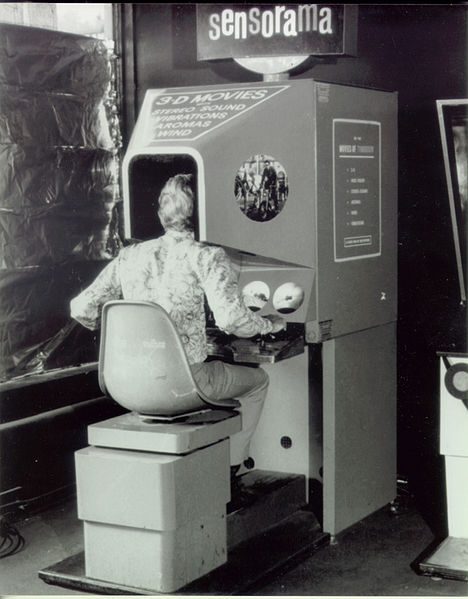Long before computers were around, people were gazing upon the unknown and were theorizing about the possibility of transporting themselves to other worlds. First doing so via their imaginations, books and stories, people also started doing 360-degree murals, known as panoramic paintings, in order for the viewer to truly feel like they’re present at another scene. Today, we’re all familiar with this concept in more real and present terms: Virtual reality. Because it still hasn’t taken over the world as anticipated, it may be difficult to define virtual reality, but few know that the VR concept has been around for more than a century. People started using stereoscopic photos and viewers as early as the 1850s and started building simulators in the 1920s. However, virtual reality as we know it today didn’t really start to take off until later on. With that in mind, here are 15 amazing facts about the history of virtual reality you didn’t know and how they lay out the frame work for what you’re using now and what will come to the future in anything from your home to transporting you to a different universe, putting you into a fully immersive gaming fitness experience, v-sport or even curing the sick!
Fact #1 – The Sci-Fi Prediction of VR – Pygmalion’s Spectacles
Stanley G. Weinbaum, a well-known science fiction writer from the 1930s, had the vision of what Virtual Reality is and what it may become, even before the official term was coined. In his 1930s short story Pygmalion’s Spectacles, he shares the idea that a wearer of a pair of goggles can experience fictional worlds through holographics, touch, smell and taste. This truly made him a visionary in the field of virtual reality.
Fact #2 -The First Attempt at a VR Experience – The Sensorama
In the 1950s, a cinematographer by the name of Morton Heilig came up with a unique concept he later developed, known as the Sensorama. Featuring an arcade-style theater cabinet, the sensorama was aimed at stimulating a person’s senses. It featured a stereoscopic 3D display, fans and smell generators, stereo speakers, as well as a vibrating chair. The idea of the Sensorama was to fully immerse a person into a film-like experience. Heilig also went on to create as much as six short movies for his device.
Fact #3 – The First Head-Mounted Displays – The Telesphere Mask and the Headsight
You might think that strapping a display on a person’s head is a relatively new idea, but it is not. The first head-mounted displays were developed as early as the 1960s. The Telesphere Mask was the first example of a head-mounted display, which provided 3D stereoscopic and wide vision with stereo sound. However, the device lacked certain immersion, because of it being a non-interactive medium. In 1961 two Philco Corporation engineers, Comeau and Bryan, came up with the Headsight. A head-mounted display, much like the Telesphere Mask, the Headsight featured magnetic motion tracking technology, which was connected to a close circuit camera. While the goggles can be named a precursor to modern virtual reality technology, they were not developed for entertainment purposes. Instead, they were developed for the military with the idea that a person would be able to immerse themselves in the remote viewing of dangerous situations.
Fact #4 – The First Computer Virtual and Augmented Reality Headset – The ‘Ultimate Display’ Concept and the Sword of Damocles
If we could name one person as the father of Virtual and Augmented Reality headsets as we know them today, it would without a doubt be Ivan Sutherland. In the 1960s, he described the concept of the ‘Ultimate Display’ that would be able to stimulate reality to a point that the viewer would not be able to tell the difference between the virtual and the real world. His concept included a head-mounted display with 3D sound and tactile feedback, a computer that would create and maintain the virtual world through this device and the ability of a user to interact with objects from the virtual world in a realistic manner. Sutherland later created the first VR/AR head-mounted display, which was connected to a computer and not a camera, known as the Sword of Damocles. However, the contraption he made was too heavy for a person to wear comfortably on their head, so the device had to be suspended from the ceiling. Furthermore, the computer generated graphics were too primitive with wireframe rooms and objects.
Fact #5 – The First Commercial VR Devices – The EyePhone Head-Mounted Displays
In the late 1960s, the virtual and augmented reality terms were coined, describing the field of technology we know today. This also encompassed the appearance of two of the very first commercial virtual reality devices in the 1980s in the face of the EyePhone 1 and the EyePhone HRX. Developed by VPL research, a company by Jaron Lanier, the devices were extremely expensive, costing as much as $9,400 for the 1 version and $49,000 for the HRX. Customers could also buy gloves that costed $9,000. While the devices didn’t really take off, which is understanding, having in mind their price, they were a major step forward in the development of virtual reality haptics and virtual reality goggles and head-mounted displays.
Fact #6 – The Virtuality Group Arcade Machine Experiences
The 1990s saw huge developments in virtual reality. With the rise of the arcades and arcade games, it was only a matter of time, before developers started coming up with new and exciting concepts and ideas. A company known as The Virtuality Group was at the cutting edge of virtual reality, launching a wide range of arcade games and machines that let either one or a couple of players immerse themselves into amazing 3D visual experiences. This happened in 1991, a year before the movie The Lawnmower Man further introduced the Virtual Reality concept to a wider audience of people.
Fact #7 – SEGA’s VR Glasses Project That Didn’t Make It
Gaming companies also knew that Virtual Reality was going to become a huge thing in the gaming world. However, while they had the vision, they were lacking the technology we have today. In 1993, at one of the first Consumer Electronics Shows, SEGA announced the Sega VR headset for their Genesis console. The prototype glasses had head tracking, LCD screens in the visor and stereo sound. SEGA’s idea was to release the product for a mere $200 at the time, but technical development issues turned the idea into one of the biggest flops for the infamous gaming company. The product was never released on the market.
Fact #8 – iGlasses
While today Apple is infamous for their use of “i” in their products, they weren’t the first ones to come up with the idea. In the 1990s, a company known as Virtual I/O came up with a headset that was capable of color 3D stereoscopic vision, as well as head tracking. Known as iGlasses, the device had a price tag of just under $1000. While the glasses were fully capable of delivering an immersive experience, they didn’t truly ignite the consumer market.
Fact #9 – Nintendo’s Virtual Boy 3D Gaming Console
Similar to SEGA, Nintendo also had the vision of putting out a Virtual Reality headset for the gaming market. They even went as far as putting a VR headset on the market, but unfortunately it didn’t make it far. Released in the mid 1990s and known as the Virtual Boy, the device was a 3D gaming console that had a 3D viewing system rigged out to look like virtual reality. While it was way cheaper than the other options on the market at the time, the device also didn’t manage to truly spark the VR movement, simply because it lacked head-tracking and quality graphics and only offered stereoscopic 3D display.
Fact #10 – The Stuntmaster and the Cybermaxx
The 1990s were huge for the development of VR, even though the devices didn’t truly capture the market the way they did now. However, they were nonetheless extremely immersive for the time. Two of the most notable head mounted displays are definitely the Cybermaxx by Victormaxx and the Stuntmaster. They basically had an LCD screen embedded in a visor, that had a head tracking system, colorful stereoscopic 3D with a price tag that was a bit below $1000. Both devices also had huge support from games on both console and PC, but they didn’t achieve the huge success the industry needed.
Fact #11 – The VFX-1
We can’t do a list about the history of Virtual Reality and not include the VFX-1. Released in the middle of the 1990s, the VFX-1 system was one of the most capable virtual reality headsets released on the market at the time. With stereoscopic 3D, multi-axis head movement detection and rotation, and the ability to play games that were not truly supported by the system, the VFX-1 was the true Virtual Reality deal at the time. Furthermore, their price tag was relatively cheap compared to other products on the market, coming at a mere $600. However, the VFX-1 was too advanced of a technology and it didn’t really take off. Later on, the company Vuzix that made the glasses was bought by Forte Technologies, which released a more expensive VFX 3D version, but it also didn’t manage to achieve huge success.
Fact #12 – The State of VR in the Early 2000s
After so many capable devices on the market and so many let downs that didn’t truly capture the audience they deserved, virtual reality didn’t see much development in the early 2000s. Virtual Reality was at the background in the development of new technology. It took a step back, letting personal devices, such as computers, laptops, iPods, smartphones and tablets take over, which may very well have been the right step. With the development of new technologies, a new door was opened for virtual reality, because now head-tracking and capable displays were cheaper than ever before. However, it wasn’t before one start-up company mentioned the idea, that Virtual Reality truly took off on the consumer’s market.
Fact #13 – The Rise of Oculus Rift
You’ve probably already heard the story, but in the 2010s, Oculus VR, a start-up company decided to release a Kickstarter project for their Oculus Rift virtual reality goggles. Little known to them, the device kickstarted the industry of virtual reality again.
Fact #14 – The VR Bandwagon
With hundreds upon thousands of people wanting to get their hands on a VR device that was still in development, huge companies, including giants like HTC and Steam, Google, Lionsgate and Samsung, among others, started heavily investing in virtual reality technologies and experiences.
Fact #15 – The VR Today
Currently Virtual Reality is growing in popularity and while companies like the Oculus Rift are losing some of their customers because of unpopular marketing practices, other devices, including the HTC Vive are taking the VR stage. Furthermore, with Google Cardboard creating the concept and other companies taking note, Smartphone Virtual Reality Goggles are letting consumers easily enjoy and experience immersive virtual and augmented reality. With huge consumer base, the multiple platforms for development, and the lack of many VR games and experiences, small start-ups as well as huge companies are investing huge amounts of money into the development of content for Virtual Reality, which might very well help VR finally achieve the world-wide recognition it didn’t manage to achieve on the market for years.
-Ivan Ivanov
Have you got any insider tips about the world of VR and fitness that you think we need to know? Make a comment below and our editors will get back to you ASAP!





